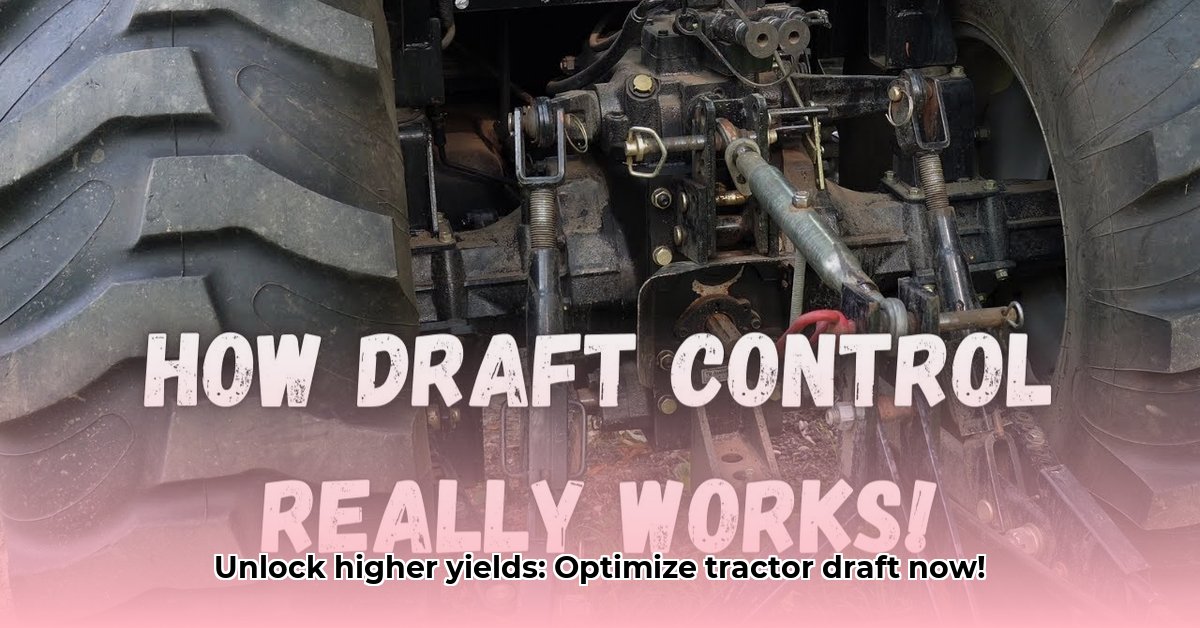
Draft Control Tractor: Optimizing Your Farming Operation
Getting the most from your tractor hinges on mastering its draft control system. This isn't merely about convenience; it's about maximizing yields, safeguarding soil health, and reducing fuel costs. Let's explore how to optimize this often-overlooked aspect of modern agriculture. For more in-depth information, check out this helpful guide: Draft Control Basics. Did you know that improper draft control can lead to up to a 10% reduction in yield? (Source: AgriWorldTime)
Understanding Your Tractor's Draft Control
Your tractor's draft control system acts as a precision assistant, ensuring implements operate consistently across varying terrains. Think of it as an autopilot for your plow or planter, constantly adjusting depth and pull for optimal performance. This consistency is vital for both efficiency and soil health. Two main system types exist: sensing and non-sensing.
Sensing vs. Non-Sensing Systems
Sensing systems: These employ sensors to continuously monitor the implement's pull, automatically adjusting hydraulics to maintain balance. This constant feedback ensures consistent performance across uneven fields and various soil conditions.
Non-sensing systems: These rely on the operator's manual adjustments via levers or hydraulic controls to maintain desired depth and pull. While simpler, they require more operator attention and expertise.
Sensing vs. Non-Sensing: A Detailed Comparison
Choosing between these system types is crucial. The following table highlights key differences to aid your decision-making process:
| Feature | Sensing System | Non-Sensing System |
|---|---|---|
| Draft Monitoring | Continuous, automated monitoring | Manual, requiring operator observation |
| Adjustment | Automatic, precise hydraulic adjustments | Manual lever or hydraulic control |
| Precision | Highly precise, consistent performance | Less precise, demands operator attention |
| Initial Cost | Typically higher | Lower |
| Maintenance | Requires sensor checks and calibration | Less frequent maintenance |
| Soil Protection | Minimizes soil compaction | Higher risk of uneven pressure and compaction |
The ideal system depends on farm size, soil variation, and budget. Larger farms with diverse terrains might benefit from a sensing system's precision, while smaller, uniform operations might find a non-sensing system sufficient. "Often, starting with a simpler system and upgrading as needed is a smart approach," advises Dr. Emily Carter, Agricultural Engineering Professor at State University.
Calibrating Your Draft Control System: A Step-by-Step Guide
Accurate calibration is paramount for optimal performance. Think of it as tuning a musical instrument—precision is key.
Preparation: Ensure proper implement attachment and adjustment, referring to your tractor and implement manuals. Level your tractor on a firm surface.
Initial Settings: Begin with the manufacturer's recommended settings for your implement and soil type. This provides a solid baseline for fine-tuning.
Test Run: Conduct a test run in a representative field area, observing implement depth and operational smoothness. Are you achieving consistent performance?
Refinement: Based on your test run, make small adjustments to the draft control settings. Remember, subtle changes yield significant results. Repeat steps 3 and 4 until optimal performance is achieved.
Record Settings: Document optimal settings for various implements and soil types. This will streamline future operations and maximize efficiency. "Keeping detailed records saves me hours each season," remarks farmer John Miller of Green Valley Farms.
Troubleshooting and Preventative Maintenance
Regular maintenance prevents costly repairs. Common issues include sensor malfunctions (especially in dusty or wet conditions), hydraulic leaks, and incorrect calibration.
Regular Inspections: Regularly check for hydraulic leaks and sensor damage or dirt.
Hydraulic Fluid: Maintain correct hydraulic fluid levels as per your tractor manual.
Sensor Calibration: Recalibrate sensors if inconsistencies arise, following manufacturer instructions.
Addressing minor issues promptly avoids major breakdowns. Preventative maintenance far outweighs the cost of major repairs.
Advanced Techniques: Precision Farming and Beyond
Integrating GPS and soil sensors enhances accuracy and efficiency. GPS ensures precise implement guidance, while soil sensors provide real-time data enabling dynamic depth and draft adjustments. This minimizes soil compaction and optimizes resource use.
Case Studies (Optional)
Real-world examples highlight the benefits of optimized draft control systems. Farmers report reduced fuel consumption, improved consistency, and minimized soil compaction. One farmer reported a 15% yield improvement after implementing a sensing system. While individual results vary, the potential for increased efficiency and reduced compaction is clear.
Conclusion: Reaping the Rewards of Optimized Draft Control
Mastering your tractor's draft control system significantly impacts your farm's productivity and sustainability. Proper calibration, regular maintenance, and consideration of advanced technologies contribute to maximizing yields while minimizing environmental impact. This investment leads to long-term benefits, increased efficiency, and improved sustainability.
Resources
- AgriWorldTime
- [Manufacturer websites – Insert relevant links here]
- [Relevant research papers – Insert links here]